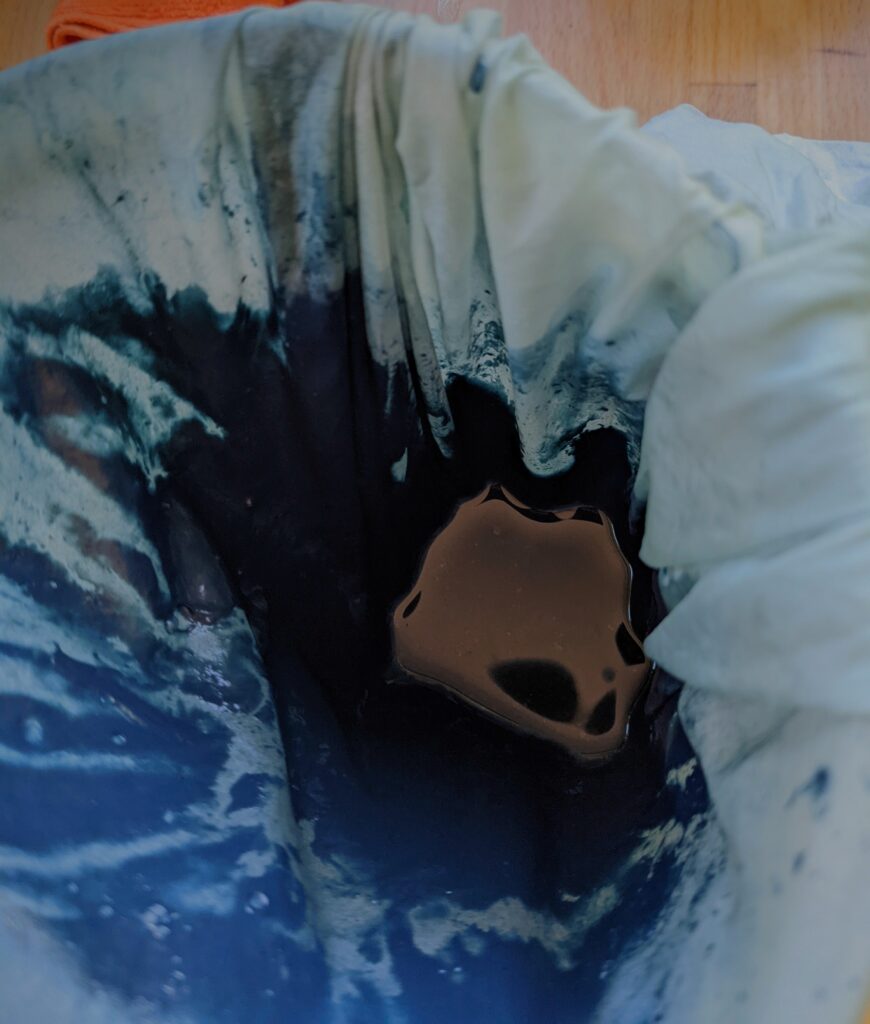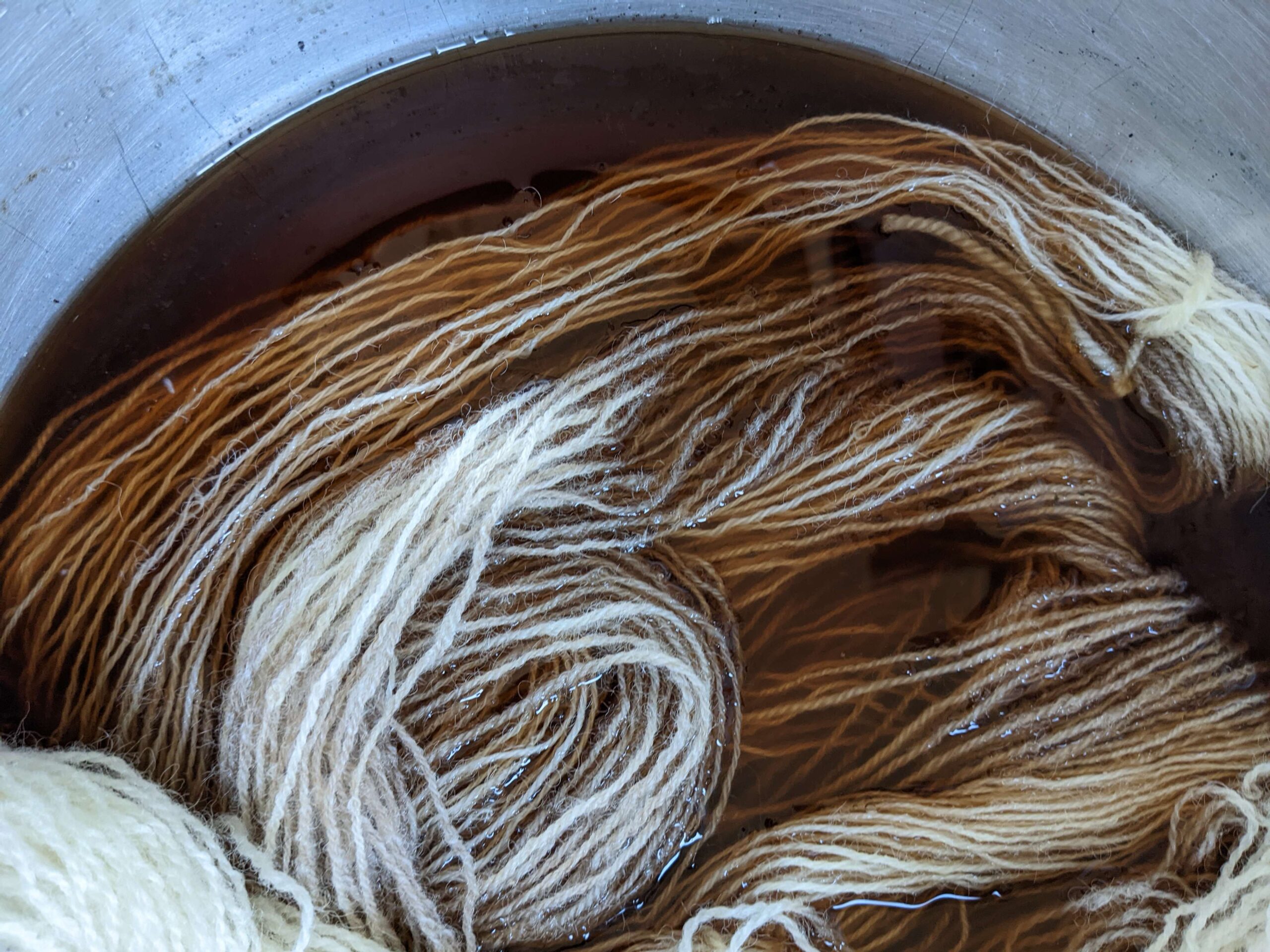
Last years woad crop was a growing disaster from start to finish. We had a terribly cold and wet Spring followed by a plague of cabbage white caterpillars which devoured the whole crop.
This year I cleared and fed a new patch of ground and sowed a good many seeds, probably too many, covered them from the start in a very fine netting to be sure that no butterflies could invade them and crossed my fingers.
Who could have thought the weather would be so different? Here in the UK temperatures have reached highs never seen before up into the low 40oC and, here in Norfolk, practically no rainfall.

Woad loves the sun and heat right? Sure but it also needs water which, after all rain catchment had been used up, was in very short supply. Lots of toing and froing with grey water, we kept it going although it didn’t seem to grow as big as it should. Maybe I shouldn’t have been too surprised at this considering. Anyhow, it grew well and more importantly, it was bug free!
Around mid July I decided to pick a few leaves and see what it would produce. I had picked some before and added to a urine vat but this never worked. I think it was too hot. (but that’s another story).
I picked the largest leaves from most of the plants and decided I would extract and save any pigment instead of dyeing straight away. So I steeped the leaves in hot water, added some sodium carbonate, aerated and let it settle. I needn’t have worried. From less than around 400 grams of leaves it produced almost 2 grams of powder. Magic!

I packed it away with powder taken from the 2020 crop and took it to Treehouse Festival where, if conditions were right, I hoped to perform some magic and produce some blues.
Well, the heat and lack of rain continued, by now there was hardly a blade of green grass left anywhere and it was sad to watch lovingly nurtured plants die before your eyes. With wildfires destroying crops, fields and houses and temperature still in the high 30’s there were big debates about using open fires and as this was my only source for dyeing in the middle of a field, I questioned whether we could dye at all and considered which dyes would work with cold water.






The dye gods were kind to us and midweek we had some rain! Not much, but enough to dampen the ground. With a 12 litre bucket of water next to the fire pit in case of emergencies, we decided to go ahead with just a small enough fire to gently heat some water. I still debated for a long time whether to use the woad powder but we were having so much fun with Weld and Madder I decided to go for it. It would have to be a non-period chemical vat and would be a bit hit and miss as all I had were some (also non-period) Ph papers. I made some soda ash from the fire to enable us to bring up the Ph of the water. This worked incredibly well with the first batch reaching well over a 14. Perfect. Even so I was doubtful of success as there seemed to be a lot of undissolved particles in the bottom of the pan. No going back at this stage and I’m so glad we carried on. Usually the wool takes a few seconds to start turning blue after taking it from the dye bath. It is the action of oxygen that makes this process happen. However, this happened instantaneously! No waiting for the colour to develop, bang, it was there. Different hues from different types of wool and obviously the colour waned as the dye bath was gradually used up. But it still kept giving. We achieved a lovely green by overdying a yellow skien and into the practically exhausted bath we placed somebody’s yellow cotton T-shirt and a skein of undyed linen. Neither of which had been prepared in any way but both took on colour. Success!
It’s now two weeks on from Treehouse and time to do something with the rest of the woad patch. I decided to extract the pigment again as it’s quicker and easier to store. I had no idea how much it would yield but was hopeful for a fair amount. It is still very warm here. The sun had been on the patch all morning so it was a good time to harvest. I picked all I could and am thinking I might get another small crop before the bad weather sets in.
I managed to pick approximately 1.3Kg of leaves. Using the usual process, I steeped the leaves in hot water and left them for about 2 hours before straining off. The water was so dark I decided I could probably use them again. So I removed the leaves to another pot and poured some more hot water on them and left them for an hour. Still the water was dark! Would it be possible to steep them again? Surely not? I looked at my yarn stash and decided I would try for some woad ‘pink‘ with whatever remaining dye was left in the leaves.
Going for ‘Pink’
I checked my yarn stash and decided to mordant some handspun with alum and a little cream of tartar for good measure. I left the wool in the pan overnight and then heated it gently the following morning. Allowing it cool, it was hung to dry. Very pleased with the beautiful result and will try this again. Blue AND pink from the same leaf!


Back to the pigment…..


It’s hard to get good pictures due to the reflections but……………
I’m very happy with the amount of pigment that this harvest has produced. Once I’ve finished washing it through I will dry and weigh it and update on the final weight per kilo. I think our long hot summer has proved fruitful.
Below is a short video that shows the pigment settling out from the second steeping of the leaves. There really is a LOT of pigment/dyestuff left after the first extraction. On more than one occasion I have managed to gain more pigment by returning the used leaves to a pot and pouring hot water on them again and letting them steep. This time I was lucky enough to do it a third time and dye with what was left over. The moral of this story is that It really pays to use your precious woad leaves more than once instead of assigning them to the compost heap after just one steeping. "Waste not want not!"
Video of the second steeping settling out of solution can be found here
